|
Nazca Lines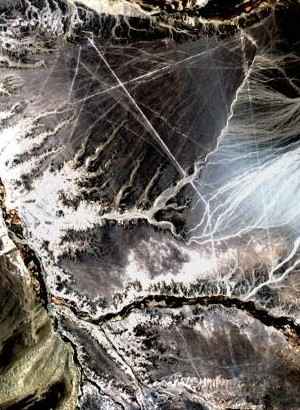 Nazca turn-ons include pottery, weaving, inventing different kinds of paint, irrigation and drawing humongous pictures of monkeys, lizards, llamas, people and dogs in the desert sands. Turn-offs include littering, drought, conquerors and extinction.
Nazca turn-ons include pottery, weaving, inventing different kinds of paint, irrigation and drawing humongous pictures of monkeys, lizards, llamas, people and dogs in the desert sands. Turn-offs include littering, drought, conquerors and extinction. The Nazca Indians lived in Peru during the first millennium of the Christian Era. The Nazca had a reasonable sophisticated society, with fairly advanced craft skills. They were subsumed after a series of conquests by neighboring tribes, all of whom are now virtually extinct. The Nazca left no great literature. They built no fabulous palaces. They were not hiding weapons of mass destruction. They didn't memorably slaughter any other culture. In short, there is only one reason that the Nazca have been elevated above the level of historical footnote—the Nazca Lines, gigantic illustrations etched into the ground which can only be viewed from high in the air. The Nazca Lines are a form of art called geoglyphs, which scientists tell us means "giant pictures drawn on the ground." From the ground, the Nazca lines basically look like footpaths. The lines were made by scraping away the dark surface dirt to reveal the lighter colored dirt underneath.
To the astonishment of the scientific community, aerial photography documented that the lines were massive pictures drawn across more than 200 square miles. In all, more than 110 pictures and simple geometric structures have been mapped in the region. About 70 of the Nazca diagrams depicted people or animals, including hummingbirds, pelicans and dogs.
Worried about the freaky-weird cheering section, scientists rushed to present a rational explanation, which we must admit is probably also the correct explanation. With virtually no historical record to work from, they argued the designs were almost certainly religious in their purpose, for the simple reason that no one would go to so much trouble except for religion. While the Nazca themselves couldn't see the pictures, their gods would theoretically have a nice vantage point to enjoy the artwork. In principle, there was no reason that a careful planner couldn't chart out instructions for drawing the actual lines. And the lack of water and wind erosion in the Peruvian desert accounted for the lines' longevity.
With all these reasonable arguments nicely articulated, the scientists sat back, clinked their brandy snifters together and fired up some celebratory cigars. Unfortunately, they had failed to account for the powerful human drive to make everything more freaky-weird than it has to be, regardless of whether or not scientists have managed to concoct a sensible explanation.
Starting in the 1950s, the lunatic fringe seized hold of the Nazca lines, and they never let go. UFO enthusiasts began to promulgate a theory that the Nazca Lines were landing strips in a giant runway for aliens who visited the idiot Nazca tribe and helped them build the Nazca Lines, which were so clearly beyond the ability of simple natives to construct. The theory continued to gain popular momentum until it was enshrined in the Lunatic Ideas Hall of Fame by Erich von Daniken in his 1968 epic of pseudoscience, Chariots of the Gods. The fallacies behind the "alien landing strip" theory are so extensive that it is impossible to enumerate all of them. However, there are a few which stand out from the crowd:
Assuming, for the moment, the Nazca hadn't invented a simple hot air balloon, there remains an intriguing mystery. Exactly why would the Nazca draw massive pictures that they could never view themselves? While the answer is still unknown, there are many rows to hoe before resorting to extraterrestrial intervention—anything from mental imbalance to religious fervor to illustrating an existential point about the meaninglessness of human endeavor. Or there could simply be no point to the lines at all. If you have to invoke UFOs every time you need to explain seemingly irrational human behavior, you'll end up blaming aliens for everything from Crystal Pepsi to Dan Quayle to Suddenly Susan. You'd think aliens would have better things to do.
|
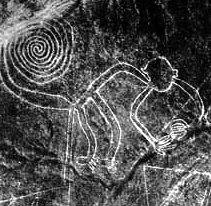 For centuries, the lines were seen simply as sacred paths used by the surviving remnants of the Nazca and other Indians in the region. In 1927, a local archaeologist named Mejia Xespe "discovered" the lines for modern audiences. When viewed from the air, he found that the apparent paths didn't really lead anywhere and speculated that they were used for pointless "walking around in circles" ceremonies by the Nazca.
For centuries, the lines were seen simply as sacred paths used by the surviving remnants of the Nazca and other Indians in the region. In 1927, a local archaeologist named Mejia Xespe "discovered" the lines for modern audiences. When viewed from the air, he found that the apparent paths didn't really lead anywhere and speculated that they were used for pointless "walking around in circles" ceremonies by the Nazca. 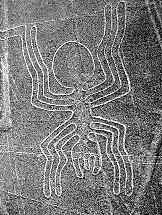 A dozen years later, an American historian named Paul Kosok tried to map out one of the Nazca Line sets and discovered that it kind of looked like a bird. He speculated that the lines functioned as a positional calendar, similar to Stonehenge. But as Kosok and his research assistant Maria Reiche (who took over the project in the '40s) continued to map the lines, they discovered more and more pictures.
A dozen years later, an American historian named Paul Kosok tried to map out one of the Nazca Line sets and discovered that it kind of looked like a bird. He speculated that the lines functioned as a positional calendar, similar to Stonehenge. But as Kosok and his research assistant Maria Reiche (who took over the project in the '40s) continued to map the lines, they discovered more and more pictures. 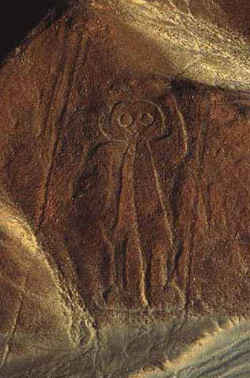 There were several reasons why this discovery was astonishing. For one thing, the first millennium C.E. was notoriously short on airplanes, which meant that (in theory) the Nazca could not possibly have viewed the pictures themselves. For another thing, the lines were just scratched into the ground, yet they had endured for several centuries. For another thing, the whole idea was freaky-weird and seemed to demand a freaky-weird explanation.
There were several reasons why this discovery was astonishing. For one thing, the first millennium C.E. was notoriously short on airplanes, which meant that (in theory) the Nazca could not possibly have viewed the pictures themselves. For another thing, the lines were just scratched into the ground, yet they had endured for several centuries. For another thing, the whole idea was freaky-weird and seemed to demand a freaky-weird explanation. 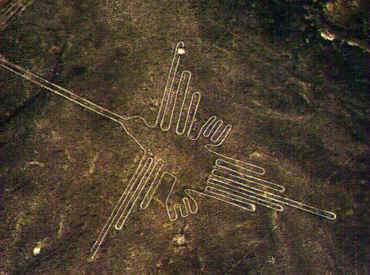
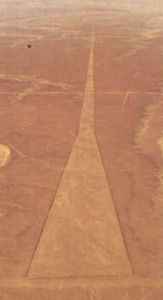 It's a simple fact that you don't need aliens—or technology of any kind—to draw pictures like the Nazca Lines. All you need is a lot of determination and intelligence. And despite the preconceptions of many modern folks, being primitive is not the same as being stupid.
It's a simple fact that you don't need aliens—or technology of any kind—to draw pictures like the Nazca Lines. All you need is a lot of determination and intelligence. And despite the preconceptions of many modern folks, being primitive is not the same as being stupid.